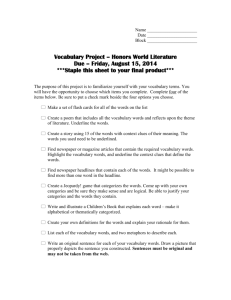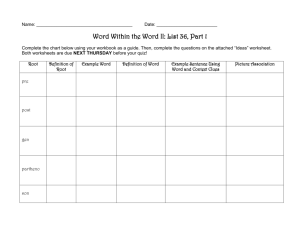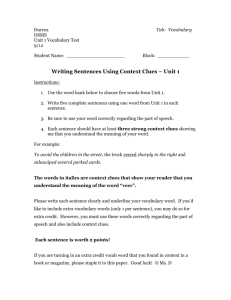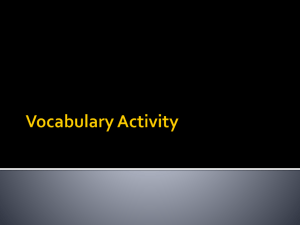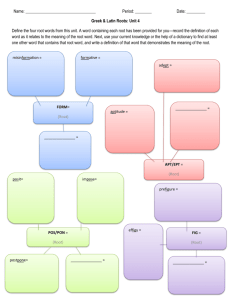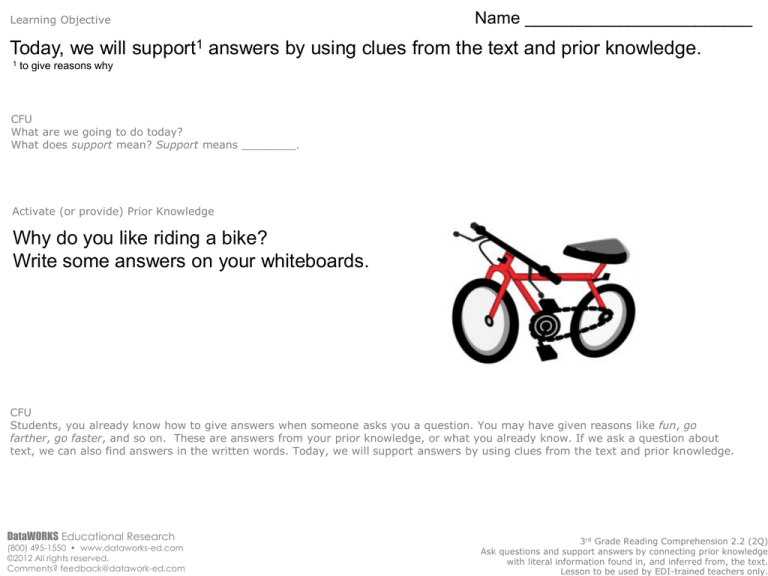
Learning Objective
Name ________________________
Today, we will support1 answers by using clues from the text and prior knowledge.
1
to give reasons why
CFU
What are we going to do today?
What does support mean? Support means ________.
Activate (or provide) Prior Knowledge
Why do you like riding a bike?
Write some answers on your whiteboards.
CFU
Students, you already know how to give answers when someone asks you a question. You may have given reasons like fun, go
farther, go faster, and so on. These are answers from your prior knowledge, or what you already know. If we ask a question about
text, we can also find answers in the written words. Today, we will support answers by using clues from the text and prior knowledge.
DataWORKS Educational Research
(800) 495-1550 • www.dataworks-ed.com
©2012 All rights reserved.
Comments? feedback@datawork-ed.com
3rd Grade Reading Comprehension 2.2 (2Q)
Ask questions and support answers by connecting prior knowledge
with literal information found in, and inferred from, the text.
Lesson to be used by EDI-trained teachers only.
Concept Development
To support answers to a question, use clues from the text and prior knowledge.
• A clue is information that can be found in the text.
• Prior knowledge is what you already know.
Example:
The Great Surprise
1. Tony received a big surprise. 2. His dad brought home a
trampoline. 3. Tony smiled all day long as he jumped on the
trampoline.
22 words
Question: How did Tony feel about receiving the trampoline?
Support
Clues from text
smiled all day as he jumped
+
Answer
Prior knowledge
I am happy when I
receive new toys.
=
Tony felt happy.
Text that does not support the answer:
Tony received a big surprise.
CFU
Which sentence does not support the answer to the question Is Sammy a good soccer player?
A. Sammy comes to school everyday.
B. Sammy scores a goal every game.
What is the difference between prior knowledge and a clue from the text?
The difference between prior knowledge and a clue from the text is ____.
In your own words, what do you use to support an answer? To support an answer, I would use _______.
DataWORKS Educational Research
(800) 495-1550 • www.dataworks-ed.com
©2012 All rights reserved.
Comments? feedback@datawork-ed.com
3rd Grade Reading Comprehension 2.2 (2Q)
Ask questions and support answers by connecting prior knowledge
with literal information found in, and inferred from, the text.
Lesson to be used by EDI-trained teachers only.
Skill Development/Guided Practice
To support answers to a question, use clues from the text and prior knowledge.
• A clue is information that can be found in the text.
• Prior knowledge is what you already know.
Support answers using clues from the text and prior knowledge.
Step #1: Read the question. Identify2 what the question is asking. (underline)
Step #2: Read the text. Identify clues from the text that support the answer. (underline)
Step #3: Add prior knowledge that helps support the answer. (write)
Step #4: Identify the supported answer. (circle)
2
find (synonym)
Chores First
1. “Make sure you finish your homework before you turn on the computer, Ron,”
said Ron’s mother. 2. “Oh, and clean up your room.” 3. Two hours later, Ron closed his
binder, snapped his math book shut, and slid it into his backpack. 4. He stretched and
smiled.
Question 1: Did Ron finish his homework?
Prior knowledge
When I close my books, I’m usually done
with my homework.
49 words
Answer
a. Yes, he finished his homework.
b. No, he did not finish his
homework.
CFU
(#1) How did I/you identify what the question was asking?
(#2) How did I/ you identify clues that supported the answer?
(#4) How did I/you identify the supported answer?
DataWORKS Educational Research
(800) 495-1550 • www.dataworks-ed.com
©2012 All rights reserved.
Comments? feedback@datawork-ed.com
3rd Grade Reading Comprehension 2.2 (2Q)
Ask questions and support answers by connecting prior knowledge
with literal information found in, and inferred from, the text.
Lesson to be used by EDI-trained teachers only.
Skill Development/Guided Practice (continued)
To support answers to a question, use clues from the text and prior knowledge.
• A clue is information that can be found in the text.
• Prior knowledge is what you already know.
Support answers using clues from the text and prior knowledge.
Step #1: Read the question. Identify what the question is asking. (underline)
Step #2: Read the text. Identify clues from the text that support the answer. (underline)
Step #3: Add prior knowledge that helps support the answer. (write)
Step #4: Identify the supported answer. (circle)
Chores First (continued)
5. Then, Ron went to his desk and turned on his computer. 6. He heard his mom
outside in the hallway. 7. Uh-oh, he thought.
22 words
Question 2: Did Ron clean his room?
Prior knowledge
If I don’t do what I’m told, I usually worry
about getting in trouble.
Answer
a. Yes, he did clean his room.
b. No, he did not clean his room.
CFU
(#1) How did I/you identify what the question was asking?
(#2) How did I/ you identify clues that supported the answer?
(#4) How did I/you identify the supported answer?
DataWORKS Educational Research
(800) 495-1550 • www.dataworks-ed.com
©2012 All rights reserved.
Comments? feedback@datawork-ed.com
3rd Grade Reading Comprehension 2.2 (2Q)
Ask questions and support answers by connecting prior knowledge
with literal information found in, and inferred from, the text.
Lesson to be used by EDI-trained teachers only.
Relevance
To support answers to a question, use clues from the text and prior knowledge.
1. Supporting answers with clues from the text and prior knowledge will help you
understand what you read because authors don’t always tell us everything.
1. Alberto received his report card. 2. All the way home, he was whistling and
grinning2. 3. When Alberto got home, he said, “Mom, I have great news today!”
2 smiling
26 words
We can use the clues from the text to tell that Alberto got good grades on his
report card.
2. Supporting answers with clues from the text and prior knowledge will help you do
well on tests.
CFU
Does anyone else have another reason why it is relevant to support answers using clues from the text and prior knowledge? (pair-share)
Why is it relevant to support answers using clues from the text and prior knowledge? You may give me one of my reasons or one of your
own. Which reason is more relevant to you? Why?
DataWORKS Educational Research
(800) 495-1550 • www.dataworks-ed.com
©2012 All rights reserved.
Comments? feedback@datawork-ed.com
3rd Grade Reading Comprehension 2.2 (2Q)
Ask questions and support answers by connecting prior knowledge
with literal information found in, and inferred from, the text.
Lesson to be used by EDI-trained teachers only.
To support answers to a question, use clues from the text and prior knowledge.
Skill Closure
Support answers using clues from the text and prior knowledge.
Step #1: Read the question. Identify what the question is asking. (underline)
Step #2: Read the text. Identify clues from the text that support the answer. (underline)
Step #3: Add prior knowledge that helps support the answer. (write)
Step #4: Identify the supported answer. (circle)
Almost Finished
1. Justin got into bed and reached for his book. 2. He thought, “I have
just two more chapters to read and I’ll finally be done! 3. Then, I can read
something much more interesting. 4. I hope I can stay awake that long!”
40 words
Question: What does Justin think about his book?
Answer
Prior knowledge
a. He enjoys the book.
I can’t wait to finish something I don’t like to do. It’s hard
b. He dislikes the book.
to stay awake when I read a book that’s very boring.
Constructed Response Closure
Gabe’s teacher put this sentence on the board: Butterflies come from cocoons made by caterpillars.
She asked him, “What insect makes cocoons?” Gabe said the answer was “butterflies.”
How can you tell that he was not correct?
Summary Closure
What did you learn today about supporting answers using clues from the text and prior knowledge?
(pair-share)
DataWORKS Educational Research
(800) 495-1550 • www.dataworks-ed.com
©2012 All rights reserved.
Comments? feedback@datawork-ed.com
3rd Grade Reading Comprehension 2.2 (2Q)
Ask questions and support answers by connecting prior knowledge
with literal information found in, and inferred from, the text.
Lesson to be used by EDI-trained teachers only.
Name _____________________
To support answers to a question, use clues from the text and prior knowledge.
Independent Practice
Support answers using clues from the text and prior knowledge.
Step #1: Read the question. Identify what the question is asking. (underline)
Step #2: Read the text. Identify clues from the text that support the answer. (underline)
Step #3: Add prior knowledge that helps support the answer. (write)
Step #4: Identify the supported answer. (circle)
My New Pet
1. Melissa couldn't make up her mind. 2. A rabbit would be gentle, but it
wouldn’t do any tricks. 3. A fish would be too boring. 4. A kitten would be nice, but
she wanted an animal she could take for a walk. 5. “Okay, I know which one I want,”
Melissa told the store clerk1. 6. “I’ll take the furry brown one that’s scratching its
ear. 7. I have always wanted one just like him! 8. I’ll need a collar and a leash.
9. I can’t wait to take him for a walk.” 10. Melissa was smiling from ear to ear.
1
person who works in a store
Question 1: What kind of pet did Melissa buy?
Prior knowledge
I know that you walk a dog on a leash.
Question 2: How did Melissa feel about her new pet?
Prior knowledge
When I’m excited about something, I can’t wait to do
it. I also may smile, too.
DataWORKS Educational Research
(800) 495-1550 • www.dataworks-ed.com
©2012 All rights reserved.
Comments? feedback@datawork-ed.com
82 words
Answer
a. Melissa bought a dog.
b. Melissa bought a rabbit.
Answer
a. Melissa was excited about her pet.
b. Melissa was unsure about her pet.
3rd Grade Reading Comprehension 2.2 (2Q)
Ask questions and support answers by connecting prior knowledge
with literal information found in, and inferred from, the text.
Lesson to be used by EDI-trained teachers only.
Periodic Review 1
To support answers to a question, use clues from the text and prior knowledge.
Support answers using clues from the text and prior knowledge.
Step #1: Read the question. Identify what the question is asking. (underline)
Step #2: Read the text. Identify clues from the text that support the answer. (underline)
Step #3: Add prior knowledge that helps support the answer. (write)
Step #4: Identify the supported answer. (circle)
Saying Goodbye
1. Mary waved goodbye as she looked out of the car’s rear window. 2. Her dad
drove the family’s car down the long driveway to the road back to the city.
3. Vacation with her cousins was over. 4. She had ridden a horse, worked in the
garden, and gone swimming in the lake.
5. She had spent a week during the summer with her aunt and uncle’s family for
each of the last five years. 6. As she sat alone in the back seat, she could feel the tears
begin to roll down her cheeks.
Question 1: Where do Mary’s cousins live?
Prior knowledge
If you have to drive back to the city,
then you most likely live in the country.
Question 2: How does Mary feel about her vacation?
Prior knowledge
When I don’t want to leave a place I really like,
I feel very sad.
DataWORKS Educational Research
(800) 495-1550 • www.dataworks-ed.com
©2012 All rights reserved.
Comments? feedback@datawork-ed.com
90 words
Answer
a. They live in the country.
b. They live in the city.
Answer
a. She enjoys it very much.
b. She disliked it and couldn’t wait to go
home.
3rd Grade Reading Comprehension 2.2 (2Q)
Ask questions and support answers by connecting prior knowledge
with literal information found in, and inferred from, the text.
Lesson to be used by EDI-trained teachers only.
Name _____________________
Periodic Review 2
To support answers to a question, use clues from the text and prior knowledge.
Support answers using clues from the text and prior knowledge.
Step #1: Read the question. Identify what the question is asking. (underline)
Step #2: Read the text. Identify clues from the text that support the answer. (underline)
Step #3: Add prior knowledge that helps support the answer. (write)
Step #4: Identify the supported answer. (circle)
The Dance Recital
1. Tonight was Lisa’s first dance recital1. 2. When she got to the recital, she found
out she was first. 3. “Oh, no! 4. What am I going to do? 5. I don’t want to go first.
6. What if I forget the dance?” cried Lisa. 7. Lisa’s mom looked at her and smiled, “You
will be great! 8. Take a deep breath and have fun.”
9. Lisa took a deep breath and walked onto the stage. 10. The music for her dance
began. 11. The song made Lisa feel calm. 12. She remembered all of her moves! 13. When
the song ended, everyone clapped and threw her flowers. 14. She ran off the stage with
a huge smile on her face.
1
performance for family and friends
Question 1: How does Lisa feel about going first?
Prior knowledge
I sometimes get nervous if I have to do
something first in front of a crowd.
Question 2: How does Lisa feel at the end of her recital?
Prior knowledge
When people clap for me, it makes me feel good.
DataWORKS Educational Research
(800) 495-1550 • www.dataworks-ed.com
©2012 All rights reserved.
Comments? feedback@datawork-ed.com
105 words
Answer
a. Lisa is scared and nervous.
b. Lisa is confident2 and feels
prepared.
2
feeling comfortable and sure of yourself
Answer
a. Lisa feels sad and disappointed.
b. Lisa feels happy and proud.
3rd Grade Reading Comprehension 2.2 (2Q)
Ask questions and support answers by connecting prior knowledge
with literal information found in, and inferred from, the text.
Lesson to be used by EDI-trained teachers only.
Periodic Review 3
Name _____________________
To support answers to a question, use clues from the text and prior knowledge.
Support answers using clues from the text and prior knowledge.
Step #1: Read the question. Identify what the question is asking. (underline)
Step #2: Read the text. Identify clues from the text that support the answer. (underline)
Step #3: Add prior knowledge that helps support the answer. (write)
Step #4: Identify the supported answer. (circle)
The Gift
1. Kim wanted to buy her mom a necklace for her birthday. 2. Her mom collects
heart-shaped necklaces. 3. At the store, Kim found two similar heart-shaped necklaces.
4. One heart-shaped necklace was crystal, and it showed all the colors of the rainbow.
5. The other necklace had blue stones, the color of her mother’s birthstone1.
6. That night Kim’s mom opened the gift. 7. She unwrapped her new heart-shaped
necklace and it sparkled with all the colors of the rainbow. 8. Her mom put it on right
away and showed it to everyone. 9. She gave Kim a big hug and said thank you. 10. Kim
1 stone that represents the month you were born
was happy with the necklace that she chose.
Question 1: What necklace did Kim buy for her mother?
Prior knowledge
I have seen crystals that shine with many colors.
105 words
Answer
a. The necklace with a blue stone.
b. The crystal necklace.
Question 2: How did Kim’s mother feel about the gift?
Answer
Prior knowledge
My mom usually loves anything I give to her.
a. Her mother said it was too expensive.
b. Her mother loved the necklace.
DataWORKS Educational Research
(800) 495-1550 • www.dataworks-ed.com
©2012 All rights reserved.
Comments? feedback@datawork-ed.com
3rd Grade Reading Comprehension 2.2 (2Q)
Ask questions and support answers by connecting prior knowledge
with literal information found in, and inferred from, the text.
Lesson to be used by EDI-trained teachers only.
EDI – Cognitive, Teaching and English Learners Strategies
Learning Objective : Support answers by using clues from the text and prior knowledge.
Cognitive Strategies
Teaching Strategies
Elaboration
Demonstration
Targeted vocabulary: support, identify, clue, prior knowledge, grinning, clerk, recital, birthstone, confident
Language Strategies
Vocabulary Words
Academic
support, identify,
Content
clue, prior knowledge
Support
grinning, clerk, recital, birthstone, confident
Multiple-Meaning
Vocabulary
Strategy
Synonym
identify,
Definition
support, clue, prior knowledge, grinning, clerk, recital, birthstone, confident
Homophone
Internal Context Clue
Listen, Speak
Read
Similar Sounds
Tracked Reading
Decoding Rules
Write
Writing
Content Access Strategies
Comprehensible
Input
Cognates
Graphic Organizer
Contextual Clues
Contextualized
Definitions
Pictures
DataWORKS Educational Research
(800) 495-1550 • www.dataworks-ed.com
©2012 All rights reserved.
Comments? feedback@datawork-ed.com
3rd Grade Reading Comprehension 2.2 (2Q)
Ask questions and support answers by connecting prior knowledge
with literal information found in, and inferred from, the text.
Lesson to be used by EDI-trained teachers only.

